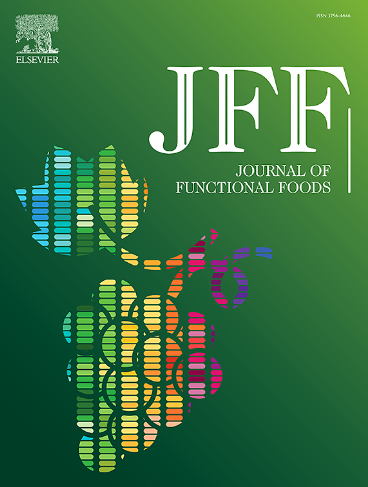硒化修饰的非消化性龙眼多糖对吲哚美辛损伤ec -6细胞的保护作用及其途径
IF 3.8
2区 农林科学
Q2 FOOD SCIENCE & TECHNOLOGY
引用次数: 0
摘要
硒与天然多糖的共价结合提供了具有生物活性的有机硒。因此,对非消化性龙眼多糖(LP)进行硒化修饰,得到硒含量分别为1.46和4.79 g/kg的SeLP1和SeLP2。评估SeLP1、SeLP2和LP(作为对照)在暴露于吲哚美辛的IEC-6细胞中的活性。与LP相比,SeLP1,尤其是SeLP2通过提高细胞活力,减少乳酸脱氢酶释放和ROS产生,减少线粒体膜电位损失,在改善吲哚美辛诱导的细胞毒性和氧化应激方面更为活跃。SeLP1和SeLP2在缓解诱导的屏障破坏方面都比LP更有效,导致屏障完整性获救,并上调三个紧密连接相关的基因和蛋白。此外,SeLP1和SeLP2都通过抑制MAPK和线粒体凋亡介导的信号通路来改善屏障功能障碍。总的来说,这种硒化和更高的硒化程度赋予SeLP2在改善吲哚美辛引起的细胞毒性和屏障破坏方面具有更高的活性。本文章由计算机程序翻译,如有差异,请以英文原文为准。

Protective effect and pathways of the selenylation-modified nondigestive longan (Dimocarpus longan Lour.) polysaccharides in IEC-6 cells with indomethacin injury
Covalent combination of Se with natural polysaccharides provides bioactive organic Se strategically. Thus, nondigestive longan (Dimocarpus longan Lour.) polysaccharides (LP) were selenylation-modified to obtain SeLP1 and SeLP2 with Se contents of 1.46 and 4.79 g/kg. SeLP1, SeLP2, and LP (as control) were assessed for their activities in IEC-6 cells exposed to indomethacin. Compared with LP, SeLP1 and especially SeLP2 were more active in ameliorating the indomethacin-induced cytotoxicity and oxidative stress, via increasing cell viability, decreasing lactate dehydrogenase release and ROS production, and reducing mitochondrial membrane potential loss. Both SeLP1 and SeLP2 were more potent than LP in alleviating the induced barrier disruption, causing rescued barrier integrity and up-regulated three tight junction-related genes and proteins. Additionally, both SeLP1 and SeLP2 ameliorated barrier dysfunction by suppressing MAPK- and mitochondrial apoptosis-mediated signaling pathways. Collectively, this selenylation and higher selenylation extent endowed SeLP2 with higher activity in ameliorating the indomethacin-caused cytotoxicity and barrier disruption.
求助全文
通过发布文献求助,成功后即可免费获取论文全文。
去求助
来源期刊

Journal of Functional Foods
FOOD SCIENCE & TECHNOLOGY-
CiteScore
9.60
自引率
1.80%
发文量
428
审稿时长
76 days
期刊介绍:
Journal of Functional Foods continues with the same aims and scope, editorial team, submission system and rigorous peer review. We give authors the possibility to publish their top-quality papers in a well-established leading journal in the food and nutrition fields. The Journal will keep its rigorous criteria to screen high impact research addressing relevant scientific topics and performed by sound methodologies.
The Journal of Functional Foods aims to bring together the results of fundamental and applied research into healthy foods and biologically active food ingredients.
The Journal is centered in the specific area at the boundaries among food technology, nutrition and health welcoming papers having a good interdisciplinary approach. The Journal will cover the fields of plant bioactives; dietary fibre, probiotics; functional lipids; bioactive peptides; vitamins, minerals and botanicals and other dietary supplements. Nutritional and technological aspects related to the development of functional foods and beverages are of core interest to the journal. Experimental works dealing with food digestion, bioavailability of food bioactives and on the mechanisms by which foods and their components are able to modulate physiological parameters connected with disease prevention are of particular interest as well as those dealing with personalized nutrition and nutritional needs in pathological subjects.
 求助内容:
求助内容: 应助结果提醒方式:
应助结果提醒方式:


